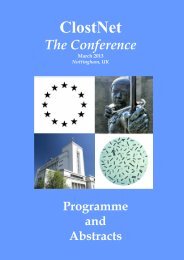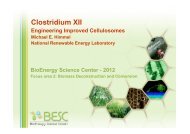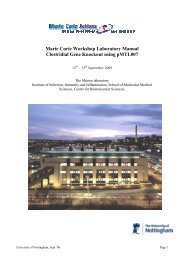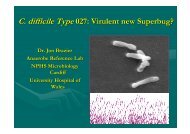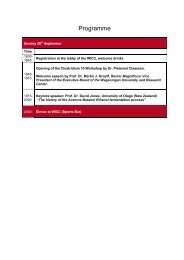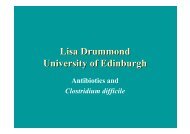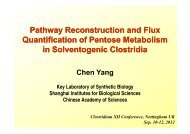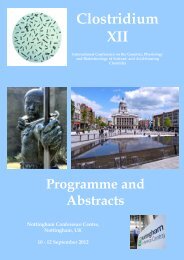abstract book - Clostridia
abstract book - Clostridia
abstract book - Clostridia
Create successful ePaper yourself
Turn your PDF publications into a flip-book with our unique Google optimized e-Paper software.
CLOSTRIDIUM BOTULINUM, A PATHOGEN FOR MAN AND ANIMAL<br />
– A SUPERIOR GROWTH PROMOTER FOR PLANTS<br />
Frank Gessler 1 , Azuka N. Iwobi 2 , Michael Schmid 2 , Anton Hartmann 2 ,<br />
Helge Böhnel 3<br />
1 miprolab GmbH, Göttingen, Germany, gessler@miprolab.com<br />
2 Helmholtz Zentrum München, German Research Center for<br />
Environmental Health (GmbH), Department Microbe-Plant-Interactions,<br />
Neuherberg, Germany<br />
3 Institute for Applied Biotechnology in the Tropics at the University of<br />
Göttingen, Germany<br />
Clostridium botulinum is well-known for its pathogenicity due its highly<br />
potent neurotoxins. Generally considered being a soil-bacterium, few<br />
aspects are known on the soil life of this species.<br />
In a field experiment the topsoil of the experimental plots was mixed<br />
with compost spiked with increasing amounts of C. botulinum type D<br />
spores. A grass seed mix with clover was sown. We found that C.<br />
botulinum persisted over 3 years, the whole observation period. In<br />
spring of year 2 of the experiment the growth of clover was observed,<br />
but exclusively on the plots treated with C. botulinum spores. The yield<br />
correlated to the amount of spores introduced into soil at the beginning<br />
of the experiment. In the higher spore concentrations the total biomass<br />
increased by 2.6 times compared to the controls. Investigations of the<br />
root zone revealed an increasing spore gradient from the rhizosphere to<br />
the root surface of the clover.<br />
In a subsequent growth chamber experiment the colonization of clover<br />
by toxigenic and non-pathogenic C. botulinum strains was investigated.<br />
Spores of the bacteria, in combination with Rhizobia were applied to the<br />
clover. The harvested plants were subjected to fluorescence in situ<br />
hybridization (FISH). Both toxin-producing and non-pathogenic<br />
C. botulinum strains were identified as endophytic colonizers of clover.<br />
Additionally, a plant growth promotion effect was observed in the<br />
growth chamber experiment as well.<br />
29



